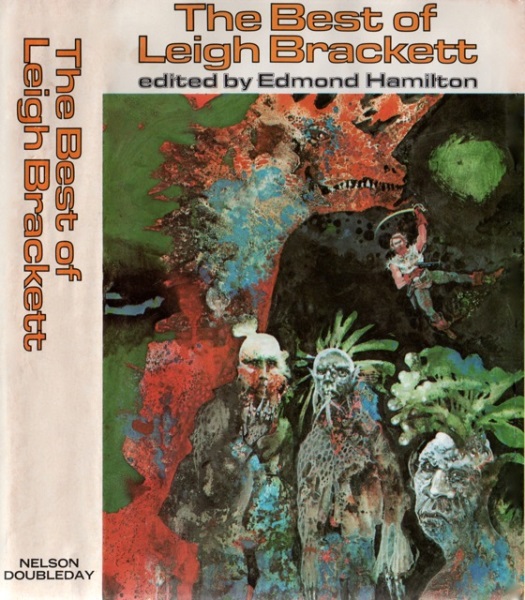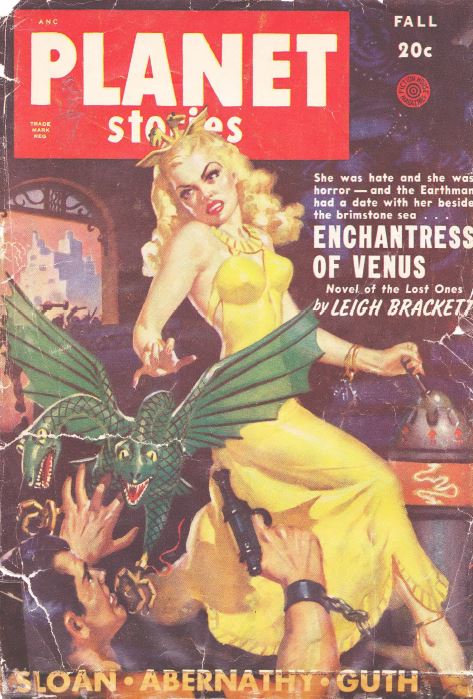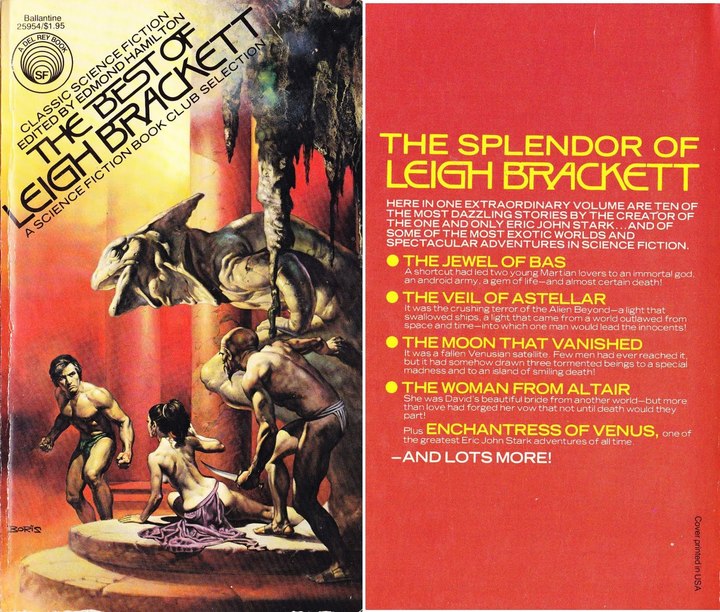Dead Cities, Space Outlaws, and Planet Gods: The Best of Leigh Brackett
Although Leigh Brackett (1915–1978) wrote planetary adventures during the Golden Age of Science Fiction and was married to Edmond Hamilton, one of the Golden Age’s most praised masters, she seems to, well, bracket the era rather than belong to it. Her stories set on fantastical versions of Mars and Venus are indebted to Edgar Rice Burroughs, while her dark emotional intensity looked forward to New Wave SF of the ‘60s. In his introduction to Martian Quest: The Early Brackett, Michael Moorcock wrote that “It’s readily arguable that without her you would not have gotten anything like the same New Wave … echoes of Leigh can be heard in Delany, Zelazny and that whole school of writers who expanded sf’s limits and left us with some visionary extravaganzas.”
The cocktail of Leigh Brackett’s style — mixing ERB and Robert E. Howard (Brackett could’ve written fantastic straight sword-and-sorcery) with the influences that shaped authors like Gene Wolfe and Jack Vance — is what makes her explode off the page in a way many of her Golden Age contemporaries no longer do. She feels startlingly fresh even when her stories occur in an impossible solar system. All the data NASA has brought back from the other planets cannot dampen Leigh Brackett’s power.
Brackett was also a successful writer of mysteries and had a second career as a Hollywood screenwriter who put memorable lines into the mouths of Humphrey Bogart (The Big Sleep) and John Wayne (Rio Bravo and El Dorado). She apparently got along well with both actors, which tells you plenty about the sort of characters Brackett enjoyed writing. Her career ended with the first draft of “Star Wars Sequel,” what we today call The Empire Strikes Back. Not much of her draft made it to the final film, but there would never have been a Han Solo, or a Star Wars of any kind, without Leigh Brackett.
 The Best of Leigh Brackett was one of the final volumes of her work printed during her lifetime. Edmond Hamilton edited it, returning the favor of her editing The Best of Edmond Hamilton a few months earlier. Unfortunately, the short story anthology isn’t the best showcase for Brackett’s fiction, since she burns brightest in her novels (The Sword of Rhiannon, one of my favorite things ever) and novellas. Hamilton could only fit ten of her stories between the covers because of their length. It’s on the weaker side of the volumes of Del Rey’s Classics of Science Fiction series, at least considering the talent of its subject, but the finest of what’s here is still stunning.
The Best of Leigh Brackett was one of the final volumes of her work printed during her lifetime. Edmond Hamilton edited it, returning the favor of her editing The Best of Edmond Hamilton a few months earlier. Unfortunately, the short story anthology isn’t the best showcase for Brackett’s fiction, since she burns brightest in her novels (The Sword of Rhiannon, one of my favorite things ever) and novellas. Hamilton could only fit ten of her stories between the covers because of their length. It’s on the weaker side of the volumes of Del Rey’s Classics of Science Fiction series, at least considering the talent of its subject, but the finest of what’s here is still stunning.
Brackett’s specialty was the “planetary romance” (sometimes called “sword-and-planet,” although “sword-and-science” makes more sense), where adventures on other worlds take on a fantastical feel and science goes into the background, treated almost like magic. This collection immediately dives into the subgenre with “The Jewels of Bas,” following the adventures of a troubadour and his wife on an unnamed planet. The story introduces the classic Brackett exotic setting and one of her favorite subjects: a god-like entity revealed as something stranger and sadder. The story appeared in Brackett’s most dependable market, the pulp Planet Stories, but it’s parsecs away from the “laser guns and bug-eyed monsters” space opera people associate with the magazine. Hamilton saw “The Jewels of Bas” as marking a major maturation point for Brackett, where she went from a good pulper to one of the best SF authors of the era.
The majority of the stories take place within the “Leigh Brackett Solar System,” a shared future setting with wild and dangerous frontiers on Mars, Venus, and Mercury. There are elements of the American Western to these outlands — especially dusty Mars and its rough towns — and the heroes are only paces away from black-hatted gunslingers and gun smugglers. But Brackett seasons these space frontiers with an elegiac tone for the alien civilizations that vanished long before Earthlings arrived in their ships.
“Enchantress of Venus” is the sole story in the collection featuring Brackett’s signature wanderer of this mournful solar system, Eric John Stark. Stark is the epitome of the Brackett hero: the tough but damaged man, an adventurer skirting the edge of outright piracy. “Enchantress of Venus” brings Stark to a distant port town across the Red Sea of Venus to attempt to locate a friend. He ends up leading a rebellion of slaves against the decadent rulers of the town, the Lahri, who are searching for an ancient power on the bottom of the gaseous sea. It’s not the best of the trio of Stark novellas published in Planet Stories in the ‘40s, but it’s still superb and should hook readers into the rest of the series.
This same Venus is the setting for “The Vanishing Venusians” and “The Moon That Vanished.” The first features flat-out horror elements as desperate human colonists hunting for safe haven fight to survive against two aggressive plant-animal (“planny”) alien species. The second is one of the volume’s highlights: it starts as an action-chase story and swerves into mystical territory when an object called the Moonfire grants the hero godlike abilities that still cannot give him what he longs for the most.
 An even darker noir strain of protagonists appears in “The Veil of Astellar.” Stephen Vance is an immortal man who lures ships into the titular Veil so a vampiric race can drain the life force of the passengers. Vance is responsible for numerous deaths, and even though the plot follows a redemption arc, Brackett leaves her hero to howl into the void in a shivery finale. It’s chronologically only the second story in the volume, which shows how fast Brackett was evolving emotionally challenging ideas within the space adventure format.
An even darker noir strain of protagonists appears in “The Veil of Astellar.” Stephen Vance is an immortal man who lures ships into the titular Veil so a vampiric race can drain the life force of the passengers. Vance is responsible for numerous deaths, and even though the plot follows a redemption arc, Brackett leaves her hero to howl into the void in a shivery finale. It’s chronologically only the second story in the volume, which shows how fast Brackett was evolving emotionally challenging ideas within the space adventure format.
The best of the solar system stories, and the pinnacle of the collection, is “Shannach — The Last.” The setting is Mercury, a more hostile planet either Mars or Venus. (In fact, it’s the world that shaped Eric John Stark in his youth.) Trevor, an Earth explorer, is searching for valuable sun-stones in the barely habitable Twilight Belt of Mercury when an accident traps him among the descendants of a crashed settler ship. These people are enslaved by Shannach, the last survivor of giant race of telepaths. Shannach is a conqueror, but also lonely, and he wants Trevor to restart the settlers’ ship so he can escape. Although filled with tension, action, and strange creatures, the biggest triumph of “Shannach — The Last” is its complex title character. Shannach has watched his civilization slowly slip away until only he remained, an immobile mind hunting for a way out. Any way out.
Brackett was skilled at science fiction taking place on ol’ Earth as well; her 1955 novel The Long Tomorrow is one of my favorite post-apocalypse tales. Hamilton includes three Earthbound stories. “The Woman From Altair” and “The Tweener” have identical themes: a famous space explorer returns home with a native from one of his travels — but the native has other ideas about their displacement. “The Woman From Altair” is solid and contains one of Brackett’s femme fatale characters; but “The Tweener” plunges into a nightmarish psychological direction that stands out even among the author’s other work. It’s unsettling to imagine a tiny, rabbit-like animal as possibly harboring millennia of resentment of a vanished species that once ruled a planet.
The third Earth story is “The Queer Ones,” set in the “earthiest” environment possible, the Appalachians. A small town reporter uncovers an alien smuggling operation among the backwoods folk. There’s a nasty attitude in this story toward the aliens not present in some of Brackett’s other fiction. Her customary sympathy toward the outsiders is here tempered with ugly xenophobia, often coming from the first-person narrator. This story leaves an unpleasant aftertaste for me, but I have to grant it some respect for achieving that, even as it closes the collection on an odd note.
The Best of Leigh Brackett was first published in July of 1977 in a Nelson Doubleday/SFBC hardback (cover art by Jack Woolhiser), then in a Ballantine/Del Rey paperback two months later (cover art by Boris Vallejo). Brackett died of cancer in March of the next year, not long after delivering her Empire Strikes Back draft to George Lucas. One of my great “What Ifs?” of science fiction is “What if Leigh Brackett had lived to do the rewrites on The Empire Strikes Back?” I love the final film, but how can I not root for one of my favorite writers, the master of space opera and planetary romance, to have gotten a chance to have a stronger guiding hand on the shape of the most famous space opera of all?
The complete table of contents:
- Introduction: “Story-Teller of Many Worlds” by Edmond Hamilton
- “The Jewel of Bas” (Planet Stories, 1944)
- “The Vanishing Venusians” (Planet Stories, 1945)
- “The Veil of Astellar” (Thrilling Wonder Stories, 1944)
- “The Moon That Vanished” (Thrilling Wonder Stories, 1948)
- “Enchantress of Venus” (Planet Stories, 1949)
- “The Woman From Altair” (Startling Stories, 1951)
- “The Last Days of Shandakor” (Startling Stories, 1952)
- “Shannach — The Last” (Planet Stories, 1952)
- “The Tweener” (The Magazine of Fantasy and Science Fiction, 1955)
- “The Queer Ones” (Venture Science Fiction, 1957)
- Afterword by Leigh Brackett
Our previous coverage of Leigh Brackett includes:
Masterpiece: The Sword of Rhiannon by Ryan Harvey
Ancient Planets and Treachery at Every Turn: Rich Horton on The Ginger Star
Leigh Brackett: American Author by Howard Andrew Jones
Vintage Treasures: The Book of Skaith: The Adventures of Eric John Stark by John O’Neill
Our previous coverage of the Classics of Science Fiction line includes:
Rich Playboys, Mad Scientists, and Venusian Monsters: The Best of Stanley Weinbaum by James McGlothlin
Vampires, Frozen Worlds, and Gambling With the Devil: The Best of Fritz Leiber by James McGlothlin
Space Colonies, Interstellar Fleets, and The Martian in the Attic: The Best of Frederik Pohl by James McGlothlin
A Neglected Master: The Best of Henry Kuttner by James McGlothlin
A Shaper of Myths: The Best of Cordwainer Smith by James McGlothlin
Smugglers, Alien Vampires, and Dark Dimensions: The Best of C. L. Moore by James McGlothlin
Classic SF from One of the Twentieth Century’s Great Masters: The Best of John W. Campbell by James McGlothlin
Wings, Wind, and World-Wreckers: The Best of Edmond Hamilton by Ryan Harvey
Shark Ships and Marching Morons: The Best of C. M. Kornbluth by James McGlothlin
Wit and Play in Classic Science Fiction: The Best of Fredric Brown by James McGlothlin
Drawing Out What it Truly Means to be Human: The Best of Philip K. Dick by James McGlothlin
The Best of Henry Kuttner
The Best of John W. Campbell
The Best of C M Kornbluth
The Best of Philip K. Dick
The Best of Fredric Brown
The Best of Edmond Hamilton
The Best of Murray Leinster
The Best of Robert Bloch
The Best of Jack Williamson
The Best of Hal Clement
The Best of James Blish
See all of our recent Vintage Treasures here.
Ryan Harvey (RyanHarveyAuthor.com) is one of the original bloggers for Black Gate and has written for the site for over a decade. He received the Writers of the Future Award for his short story “An Acolyte of Black Spires.” His stories “The Sorrowless Thief” and “Stand at Dubun-Geb” are available in Black Gate online fiction. A further Ahn-Tarqa adventure, “Farewell to Tyrn”, is available as an e-book. Ryan lives in Costa Mesa, California. Occasionally, people ask him to talk about Edgar Rice Burroughs or Godzilla.

Yeah! Another Del Rey Best of down!
I agree that “Shannach — The Last” is very very good. I liked “The Queer Ones” quite a lot, however.
I kind of regret that I never read Brackett back in my formative (high school days), but that just means that now I have the pleasure of reading most of her stuff for the first time.
Thanks for adding Leigh Brackett to Black Gate’s BEST OF… series. She was the Queen of Sword & Planet (I like your term Sword & Science better) and doesn’t get the acclaim I think she deserves.
I agree completely with your assessment of The Sword of Rhiannon: a masterpiece, not just my favorite of her novels, but one of the best SF novels of the 20th Century.
Thanks again.
I’ve recently been reading through the three novels of her late Eric John Stark series, collected in the Book of Skaith. The gorgeously impossible never dates, and Brackett still weaves a wonderful spell.
Pretty sure the cover on that Ballentine is by Boris. Had some art collectors cards and the pic rings a bell.
In my house, Brackett holds a place of honor only shared by Robert E. Howard and Harold Lamb. She is one of the very best.
I sure do love “Shannach — The Last.” Like you I think highly of “The Veil of Astellar.” But I think my very favorites in this collection have got to be “The Moon that Vanished” and “Enchantress of Venus.” I’ve re-read those two numerous times.
Great, great stuff…
She is in the holy trinity of fantasy fiction (with Howard and a revolving member, currently old favorite C. A. Smith). The simple intensity of her prose is unmatched.
“The Tweener” made me cry in high school. Still makes me sad.
It’s been a while since I read “The Queer Ones” but I don’t recall thinking that she or the reader was supposed to share the narrator’s xenophobia. “All the Colors of the Rainbow” (not included here) made her stance on that pretty clear.
Nice write up!
@MisterFrauBlucher – No, I don’t believe we’re meant to share in the narrator’s xenophobia in “The Queer Ones” either, but Brackett is too good a writer not to leave the reader feeling a bit complicit. This is why I respect the story while not completely loving it.
[…] Black Gate » Dead Cities, Space Outlaws, and Planet Gods: The Best of Leigh Brackett. […]
[…] This idea owes something to Ryan Harvey’s depiction of Leigh Brackett over at The Black Gate […]